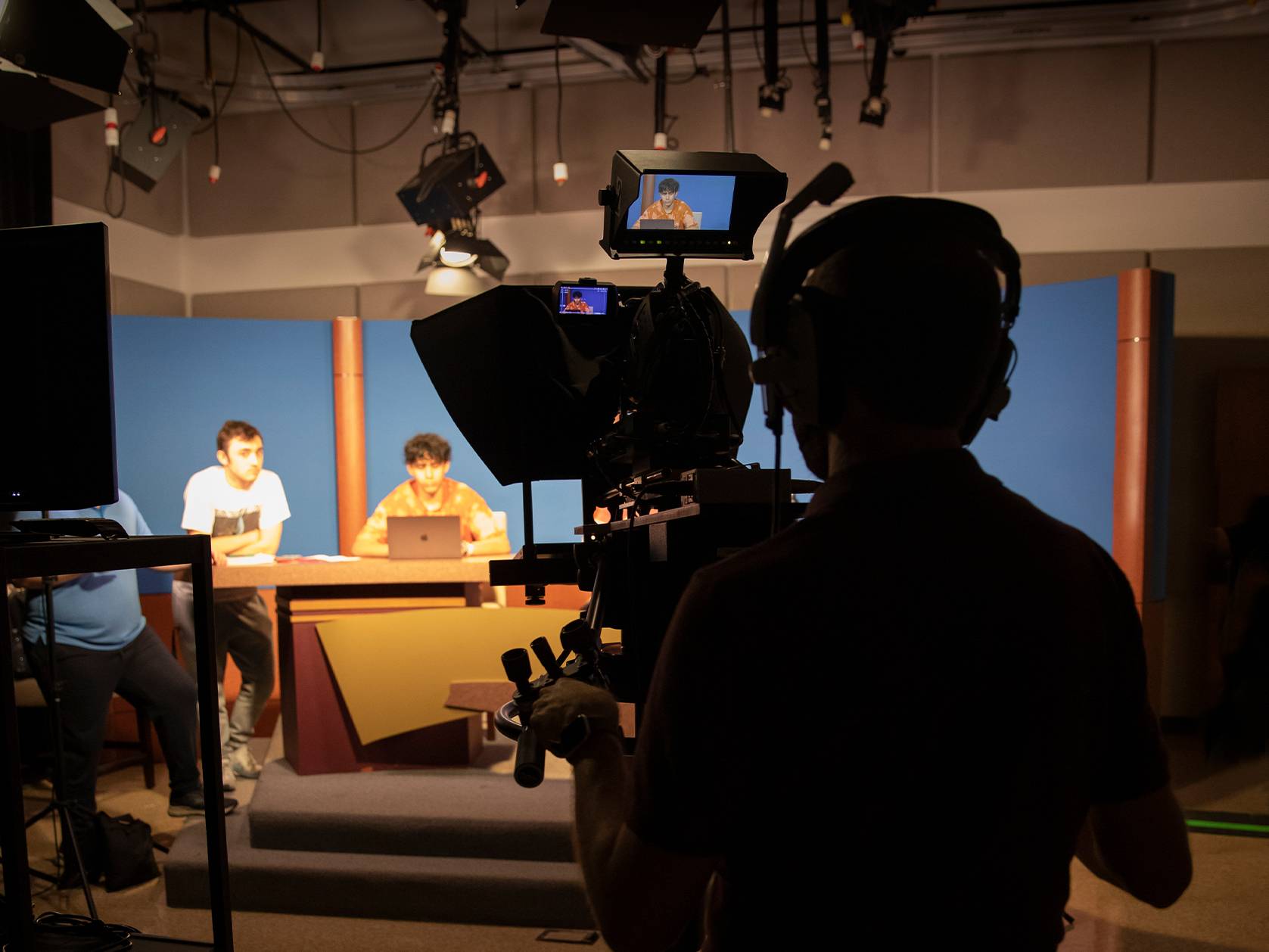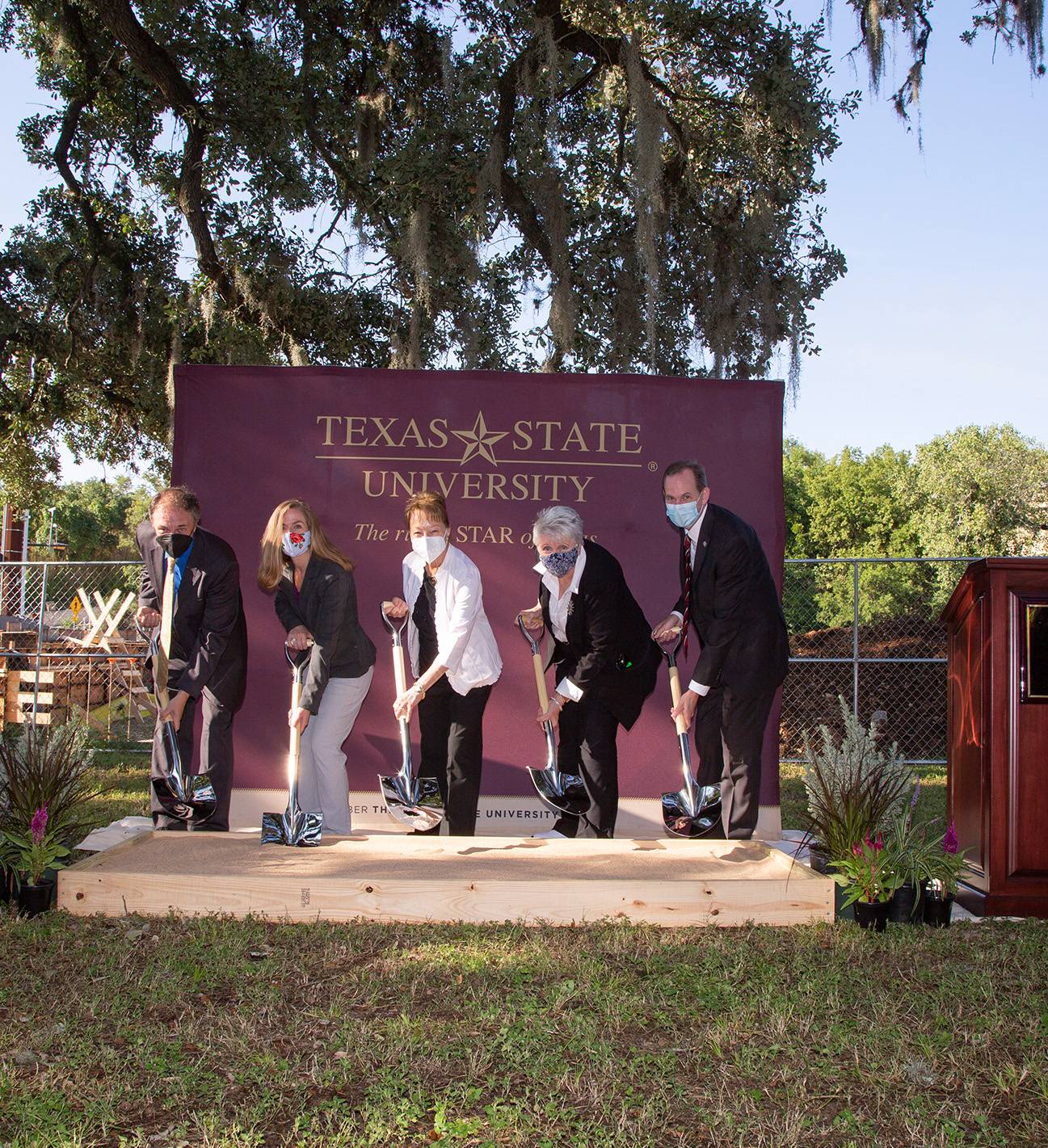
Opening this fall, Live Oak hall will serve media and film students
By Julie Cooper
For Tim England, associate professor in the School of Journalism and Mass Communication, the newest building at Texas State University is a “longtime dream finally coming true.”
Set to open this fall, Live Oak Hall is a $10 million facility that will serve about 600 students and faculty of the College of Fine Arts and Communication. The building will provide a home for mass communication students and meet the needs of the growing film program in the Department of Theatre and Dance. It will feature a film soundstage, TV studio, recording mix classroom, editing lab, Foley room for sound effects, and offices.

The highlight of Live Oak Hall is its dedicated television studio. For 30 years, the School of Journalism and Mass Communication has rented studio space at the Alkek Library to teach video production and television news courses. The facilities in Live Oak Hall, including a control room and media flex rooms for editing, will help ensure that Texas State maintains its stature as a professionally accredited program. The new television studio will also serve as the home of “Bobcat Update,” an award-winning and campus-oriented newscast produced by students majoring in electronic media. Sports and interview programs will also be produced in the new studio. “We have all along hoped to have our own studio,” says England, who has been part of the Texas State faculty since 1993.

New Faculty On Board
Dr. Judy Oskam, director of the School of Journalism and Mass Communication, says that most programs of similar size at other universities have TV studios. “I’m excited that our students and faculty will finally have the state-of-the-art facilities that they deserve.” To provide additional coursework and studio programming, new faculty — Dr. Youjeong Kim and Dr. Ali Forbes — joined the university last fall. Kim was on the faculty at the New York Institute of Technology, and Forbes is a graduate of the Cronkite School of Journalism and Mass Communication at Arizona State University.
Since its inception, graduates of the Texas State program have been recruited for top jobs in media markets around the country such as “Good Day LA” and “Good Morning Dallas.” The list of working alumni is long and includes such names as Polo Sandoval (B.A ’07), CNN News; Rita Garcia (B.A. ’06), KTRK-Houston; Malik Mingo (B.S. ’17), WWL-TV New Orleans; Isamar Terrazas (B.A. ’14), assignments manager at Telemundo 40/NBC Universal; Mike Kickirillo (B.A. ’88), director/broadcasting San Antonio Spurs; and former WFAA-Dallas anchorwoman Gloria Campos (B.A. ’76).
England explains that smaller TV markets, which Texas has plenty of, are eager to hire multimedia journalists. “They shoot, write, edit, and do the whole thing,” he says, adding that more than 27,000 people are employed in the nation’s TV news industry. “Students coming out of our university are as qualified as anyone — and they often land at stations in Austin or San Antonio within three to five years,” he says. “Those who have ambition and talent, they’re going to make it.”
For many graduates, the work goes beyond daily news reports because jobs are plentiful with businesses that have a strong social media and online presence. “Everybody wants video,” England says. “Our students can take a story and enhance it with video.”
Film Production
The students and faculty in the B.F.A. Theatre, Film Production degree will also get the maximum use of Live Oak Hall. The program accepts students based on their GPA and a film portfolio that they create. The department received more than 50 applications for fall 2021, says Johnny McAllister, assistant professor and head of the film concentration. “I had planned to accept 15 of those but the quality was so strong and I’m anticipating us being able to move into this building,” he says, explaining why 37 applicants were accepted. Four new part-time instructors have joined the faculty: Monique Walton, Kenya Gillespie, Vanessa Uhlig, and Ben Bays. “What I’m most proud of in this program is the quality of our faculty. They all have flourishing film careers,” McAllister says.
McAllister is himself an award-winning filmmaker and screenwriter. In 2019 he wrote and executive produced “Bull” with his wife, Annie Silverstein, and Walton as creative producer. It premiered at the Cannes Film Festival, won the top three awards at the Deauville American Film Festival, and was scheduled to make its U.S. premiere at the SXSW Film Festival in March 2020 — just when movie houses closed because of COVID.
“We are going to be in a state-of-the-art building, and if we really want to compete regionally or nationally our students need to be using the latest equipment,” McAllister says. This includes lighting and cameras. “We need to stay on that sort of cutting edge and that takes a significant investment. In addition to having a great facility, we need students familiar with that equipment when they step in the real world,” he adds.
The Texas State Film Club, which has recently seen a rise in its membership, gets high praise from McAllister. “It’s not just film appreciation — they are vital to everything we do in the film program. They help set up guest speaker screenings, run workshops, and welcome freshmen into our community. They even help each other get jobs after graduation,” he says.
Miranda Watchler, a junior in the film program, is a member of the film club, which that includes about 55 students. The New Mexico native says she started out as a digital media major, before learning about the film concentration. Watchler hopes one day to open her own production company. “I’ve had the opportunity to look at the plans (for Live Oak Hall) and saw all that it will have. I am very much looking forward to having a film room. I can’t wait to see what opportunities it will bring,” she says.
McAllister says graduates of the program will have the skills to produce a feature film or a pilot of a TV show. “We’re teaching what I call the complete filmmaker,” he says. Another strength that McAllister sees in the program is the proximity to theatre. “I think film is its own thing, but the fact that we have all of these shared skill sets and that we’re situated within the theatre department is special and unique. We have access to all these wonderful actors, technicians, costumers, and designers. We have a department full of creative artists at play.” ★
There are several ways for Bobcats and film/TV lovers to support this project, including naming opportunities. For more information contact Dr. Dan Perry in the Office of Development, dperry@txstate.edu or (512) 245-4055.